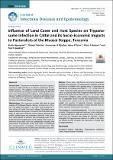| dc.description.abstract | Introduction
Trypanosome infections result into trypanosomosis in cattle and this is an infection detrimental to pastoralist income. The patterns of transmission are thought to be influenced by ecological factors including wildlife and land cover. We assessed the influence of the relative abundance of wildlife and land cover (cultivation and habitat type) on the presence of trypanosome infections in replicated cattle herds of the Maasai Steppe.
Methodology
We undertook a cohort field study in three villages of the Maasai Steppe: Sukuro, Kimotorok and Oltukai. The study took place in July 2017 and October 2017 and utilized 50 cattle from each village. Pastoralists were asked questions during each visit when blood sampled were taken to seek their viewpoint on the relative abundance of wildlife, habitat types and cultivation observed in the areas their cattle grazed. In addition, the percentage cover of cultivated land and habitat types in the grazing areas were determined during field visits and participatory mapping with pastoralists. A systematic review was used to understand the socio-economic importance of trypanosomosis. The species of trypanosomes in cattle were identified using nested Polymerase chain reaction (n-PCR).
Results
There was a significant and positive association between the presence of trypanosome infection and the abundance of wildlife within grazing areas, in particular the abundance of buffaloes (Odd Ratio > 1, P = 0.038, 95% CI 1.26 to 1.38) when cattle grazed in woodland habitats. Cultivation on grazing areas had a negative association with the presence of trypanosome infections (R < 1, P = 0.001, 95% CI 0.0614 to 0.0986) in cattle but this varied between villages. A systematic review showed that trypanosomosis had socio-economic impacts such as loss of income, reduced quality, and quantity of livestock products, management cost, and inadequate provisions of socio-services and potential zoonotic transmission to humans.
Conclusion & recommendations
The socio-economic impacts of trypanosomosis will continue to be a challenge to pastoralists when cattle are grazed close to wildlife areas which are infested with tsetse fly habitats. Control strategies for trypanosome infection in cattle on the Maasai Steppe should consider the interaction of cattle with ecological factors. | en_US |

